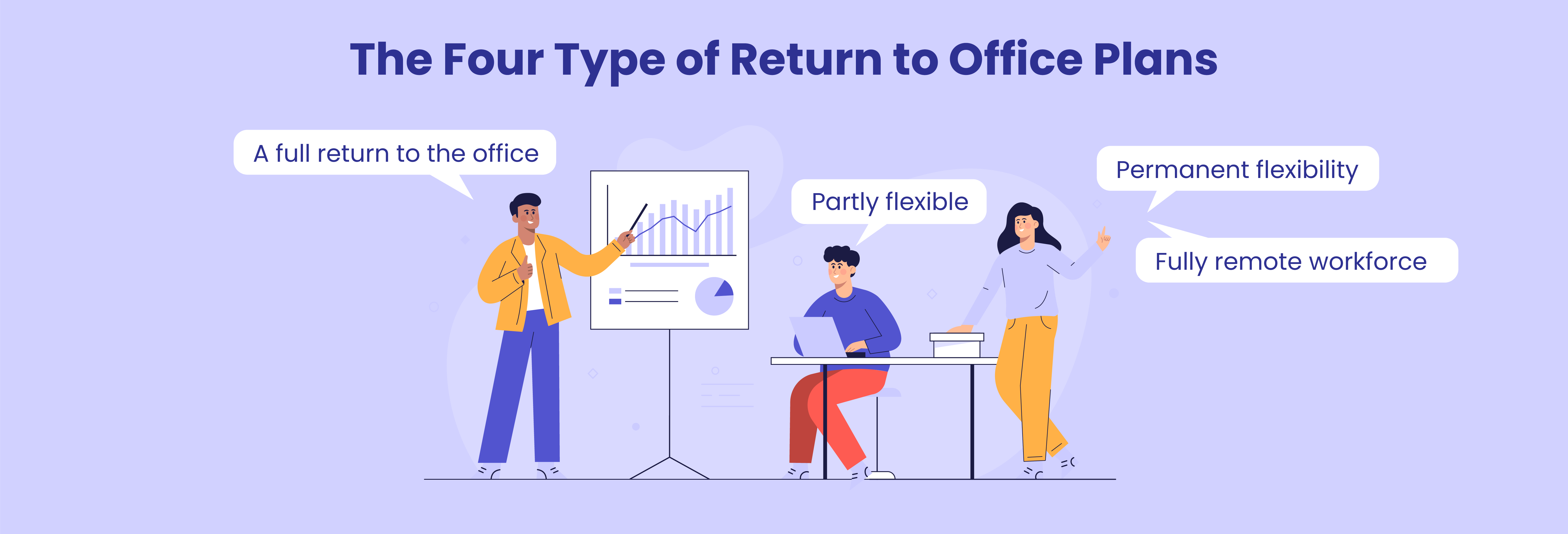In 2020, the major concern for HR professionals was to facilitate a smooth transition of their employees to remote operations. Now that cases are dropping and vaccinations are speeding up in 2022, organizations worldwide are wondering when and how to bring employees back to work.
However, considering how the situation hasn’t normalized 100% and around 81% (The Harvard Gazette) of employees aren’t willing to go back to the office full-time, you must plan the return mindfully. Return to office requires serious considerations regarding what will be the best for your employees and the overall business.
So, how do you build an efficient and effective return to office plan that can make your management and employee happy and safe at work?
That’s exactly what we’re going to discuss in this article.
The four types of return to office plans:

Before we dive into the steps you can take in planning for the return to working onsite, here are four types of return to office plans you can consider:
1. A full return to office plan
This is the most traditional way of the four. If your employee used to work face to face before the pandemic, you’re likely to go for a full return to office plan. In fact, it is the most preferred route for workers in the service industries, such as banking, communications, hospitality, retail, and so on.
However, before you ask your employees to come back, make sure you consider the health and safety of your employees, your customers, and the success of your business. Also, closely monitor the government regulations regarding office attendance and have social distancing rules in place.
2. Partly flexible
Creating a partly flexible return to office plan means that your employees will work from home for a fixed number of days per week and then come back to the office based on their own needs or for specific meetings and projects. You can also develop a rotating schedule according to which some employees will work from home while others will work on-site.
This is an excellent way to maintain employees’ health by allowing them to come into the office only a few days a week.
3. Permanent flexibility
Permanent flexibility is the plan that allows employees to decide if they want to work entirely from home or come into the office and work full-time — either permanently or for a few days a week. For example, designers, IT professionals, digital content creators, customer service reps, etc., are some of the roles that can smoothly transition to working remotely.
This model is suitable for organizations functioning well with a remote workforce, so offering such flexibility won’t harm their business.
4. Fully remote workforce
This return to office plan is for companies who want to adopt a 100% remote model where all the employees will work from home. If your business thrived during the pandemic with remote operations, this could be the perfect option for you. Not only does it reduce your office space, but it also saves you a lot of money and time.
Whatever model you choose, the first and the most crucial thing you need to consider is whether your office is ready for the return of employees.
Is your office ready for the RETURN?
Conducting a successful return to office plan can be daunting, especially when employees have different opinions. Calling workers back to the office without any preparation can result in the failure of your business and reduce the employees’ trust in your company. On the other hand, delaying the return for companies who have suffered due to remote operations can further worsen their situation.
Before you structure your return to office plan, it’s crucial to ensure whether your office is ready and safe for the return. Here’s how you can do it:
- Talk to your employees, like a focused 1:1, to better understand their personal needs and potential concerns. If workers are hesitant or afraid, address their problems and plan accordingly.
- Offer a flexible timeline to employees on their return to the office. For example, you can decide on a 3-month approach to bringing workers back to the office. Some employees may return to the office in June, while others will be back by September.
- Since COVID-19 spreads through respiratory droplets suspended in the air, invest in ventilation and air filtration systems.
- Cleaning or disinfecting more frequently may be wise if your office is at an increased risk for infection. However, when there are no confirmed or suspected COVID-19 cases in the place, cleaning once a day is enough.
- Post signs in the parking lot, kitchen, cafeteria, outdoor seating areas, entrances, and exits reminding employees and visitors of wearing a cloth face covering, practicing social distancing, and staying home when sick. Also, ensure these posters are accessible for non-English speakers too.
- Set up sanitizer stations in the kitchen, lobby, entrances, exits, hallways, and throughout the shared space.
- Ensure regular temperature checks to reduce the possibility of transmission of COVID-19 in your workplace.
How to execute your return to office plan?

Now that your office is ready for the return, it’s time to execute the return to office plan. Here’s how you can do it effectively:
1. Conduct surveys
To avoid losing the best talent to competitors, it’s crucial to make employees heard — especially regarding their health and workplace safety.
Conducting an employee pulse survey is an excellent way to gain insights into your workers’ preferences when going back to work. Plus, surveys can also help you understand how often employees would like to work from the office, the tools and tech you need in the hybrid environment, and their concerns regarding the ongoing pandemic.
You can use the survey results to create workplace policies, such as seating arrangements, sanitary practices, social distancing, tools and technology requirements, and more. Further, you can segment data according to the department, gender, location, and generation to get more specific insights from your workers.
2. Build a vaccine check
Next, you need to decide how to bring people back to the office without compromising their health and safety. In fact, this is one of the top concerns that an employee will have when returning to the workplace.
As COVID-19 vaccines are speeding up, organizations must have vaccination policies to securely track vaccination status and mitigate the risk of infections. Especially in industries that will require employees to perform their jobs on-site, building a vaccine check is critical.
To successfully implement this program, companies need a reliable system where they can collect data about the current vaccination status of the employees. Here’s how you can do it:
- Manually: Many businesses may track and collect this information by hand. This involves requesting copies of vaccination certificates and manually storing this data in physical locations (as hard copies) or a digital drive.
Vaccine tracking software: It is the preferred method for tracking vaccination status. Not only does it reduce manual labor and errors, but it also ensures only selected employees have access to this information. Plus, it also allows workers to self-attest their health status — including whether they’ve been vaccinated, the date of doses, and the name of the vaccine they’ve received.
3. Get your tech in place
While working remotely, we saw a dramatic shift in organizations using tech to communicate from different locations and manage projects effectively. Slack, Microsoft Teams, project management tools, screen recording apps, and HR software have helped employees and managers bridge communication and collaboration, irrespective of their location.
Now that you are planning to move back to the office, it doesn’t mean you should ignore the use of these digital tools. In fact, you must keep taking advantage of these tools to improve the way your work gets done in your organization. This works great for businesses with a hybrid workplace arrangement.
For example, you can continue using a whiteboard tool to brainstorm ideas and gather thoughts and feedback. Further, recruitment software can help you source the best talent from across the world and even help screen candidates quickly.

4. Ensure safety and comfort
Health and safety are the most critical employee concerns when returning to a physical office setting. So, in 2022 and beyond, organizations that consider employee well-being over profits are likely to see more employees walking inside the door.
Below are some health and safety matters which require special planning and consideration:
- Sanitization practices
- Cleaning and disinfecting practices
- Social distancing policy
- Temperature checks
- Employee health screening protocols
- Vaccination and contact tracking policy
- The process to handle workplace detected illness
- Return to office health and safety training for employees
It’s crucial that organizations communicate these policies clearly to the employees for the return to office program to run smoothly. Further, address employee questions regarding salary, benefits, office requirements, location, and work schedules to avoid any confusion.
Prioritizing the health and safety signals to employees that your organization is committed to protecting them. Plus, it reassures your workers that you are providing a comfortable, safe and stable environment.
5. Revise your seating plan
One thing that COVID-19 has taught us is social distancing. While considering returning to the office, it’s essential to review your current office layout and arrange seating according to social distancing guidelines.
As permanent or dedicated desks for employees are becoming obsolete post-pandemic, it’s time to consider a more flexible model with hot desking. It is a seating arrangement where employees can reserve a desk for a particular day — either on the same day or in advance.
Desk hoteling is another seating arrangement that allows employees to reserve a desk for a set time. While hot desking is usually short-term, desk hoteling is often long-term bookings, such as a day, weeks, or even months.
To implement these arrangements successfully, you can leverage desk booking software. You can secure a workforce for a specific period with just a few clicks, ensuring appropriate distance between workers.
Further, if an employee tests positive for COVID-19, administrators can quickly trace the individuals and teams that have used desks, conference rooms, and other workspaces in the office. Plus, they can track desk booking analytics to check which workers came to the office that day and inform them of possible exposure.
6. Build a hybrid workplace
Let’s be honest; not every employee will feel ready or comfortable returning to the office. This is where adopting a hybrid workplace model can be your best bet.
The hybrid work model is an arrangement that provides employees with an option to work remotely or on-site. There are four types of hybrid setups offered to workers:
- The at-will model allows employees to choose the work arrangement (remote or in-office) that works best for them on any given day.
- In the split-week model, companies split the week between working from home two to three days a week and coming to the office two to three days a week.
- The shift work model allows employees to work in shifts, for example, working morning shifts from home and evening shifts on site.
- Finally, the week-by-week model allows employees to work from home and on-site on alternate weeks.
Whatever model you choose in your company, make sure to put in place updated policies, processes, and tools for a successful hybrid workplace.
You can conduct employee surveys to better understand the best approach for your organization. Ask them questions regarding their ideal in-office schedule, safety protocols they want in place, or vaccination or social distancing policies.
Further, deploy different tools to support this new way of working. For example:
- Desk booking software to reserve a desk in advance
- Visitor management tool to ensure safe visits from vendors and clients
- Room scheduling software to book space for meetings and collaboration.
7. Invest in new-age technology
For a seamless and smooth transition into the in-office work environment, investing in new-age technology should be one of your top priorities. Not only do they ensure a safe return to the office but also take a massive burden off the HR’s shoulders — who’s responsible for handling the workers’ health, legal, and employment issues.
Further, a technology-enabled workplace can positively impact the employee experience, increase collaboration and productivity, and streamline operations — boosting your company’s chances to attract and retain the best talent.
Here are a few scenarios where using AI-enabled HR tools, like Leena.ai, can be your best option:
- Keeping track of employee health and vaccination status
- Onboarding and offboarding workers
- Keeping your employers informed about the meetings, new policies, announcements, and more
- Managing employee queries and requests
- Monitoring employee attendance and performance
- Sourcing and recruiting top-notch talent — both remotely and in-office
To build a safer workplace, explore Leena.ai’s newly launched COVID-19 workplace response suite.
Return to Office Plan 2022: Revamping the Purpose

85% of the employees are looking forward to returning to their offices. However, they aren’t eager to return to the pre-COVID work style. In fact, they want a hybrid work arrangement, where workers have access to an office but also the flexibility to work from home.
In short, the offices are changing and organizations that make flexibility and diversity the top priorities in their workplace model are more likely to thrive.
Going into 2022, here are a few parts of the office you must adopt and leave behind to keep your management and employees safe, happy, and feeling supported.
Things to adopt in 2022
- If you’re aiming for happier employees, shift your mindset regarding perks. More employees will be working from home, so they want discounts on things they can enjoy outside of work — such as travel discounts, lunch stipends, etc. Plus, they crave wellness and mental health benefits at work.
- To promote flexible office space and ensure distancing, consider hot desks with desk booking software. This will allow employees to reserve a desk in advance for a particular day. Further, you can also leverage the desk hoteling system where workers can book a desk for a specific period — days, weeks, or even months.
As you transition to a hybrid workforce, adopt tools that enable successful communication and collaboration for employees — whether in-office or working from home. For example, project management tools like Asana and Trello can help keep track of project statuses and deliverables. Further, HR tools can effectively recruit and onboard employees and manage their performance remotely and on-site.
Things to leave behind in 2021
- Requiring employees to be in the office from Monday to Friday, 9-5, should be a big NO as not everyone is comfortable with this approach post-pandemic. Further, it might create tension among the workforce, lowering their productivity and engagement levels.
- Since not all your employees will come to the office at the same time, organizations can support flexibility by not having dedicated desks for them.
Since employees will be spending less time in the office, flashy perks like ping pong tables and kombucha on tap won’t be enough to retain them for longer.
Summing up
Offices are essential for employees to collaborate as a team, in-person interactions, and build meaningful bonds with co-workers. However, it might look different in 2022. Hence, the major challenge for HR professionals will be maintaining this in-person connection while keeping the employees safe and happy and ensuring business success.
So, whether you’re making a return to office plan or are still in the consideration phase, adequate preparation, strategic planning, and clear communication are the key to ensuring a seamless transition from remote work to in-office collaboration.
Ready to plan your return to office? Explore the power of AI with Leena.ai.






